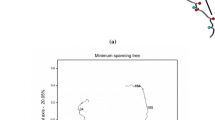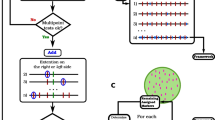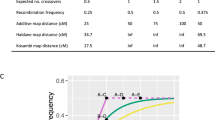Abstract
Efficient construction of large-scale linkage maps is highly desired in current gene mapping projects. To evaluate the performance of available approaches in the literature, four published methods, the insertion (IN), seriation (SER), neighbor mapping (NM), and unidirectional growth (UG) were compared on the basis of simulated F2 data with various population sizes, interferences, missing genotype rates, and mis-genotyping rates. Simulation results showed that the IN method outperformed, or at least was comparable to, the other three methods. These algorithms were also applied to a real data set and results showed that the linkage order obtained by the IN algorithm was superior to the other methods. Thus, this study suggests that the IN method should be used when constructing large-scale linkage maps.

Similar content being viewed by others
References
Buetow KH, Chakravarti A (1987) Multipoint gene mapping using seriation. I. General methods. Am J Hum Genet 41:180–188
Crane CF, Crane YM (2005) A nearest-neighboring-end algorithm for genetic mapping. Bioinformatics 21:1579–1591
de Givry S, Bouchez M, Chabrier P, Milan D, Schiex T (2005) CARTHAGENE: multipopulation integrated genetic and radiated hybrid mapping. Bioinformatics 21:1703–1704
Echt C, Knapp S, Liu B (1992) Genome mapping with non-inbred crosses using GMendel 2.0. Maize Genet Coop Newsl 66:27–29
Edwards JH (1971) The analysis of X-linkage. Ann Hum Genet 34:229–250
Ellis THN (1997) Neighbour mapping as a method for ordering genetic markers. Genet Res 69:35–43
Eppig J, Eicher EM (1983) The mouse linkage map. J Hered 74:213–231
Falk CT (1992) Preliminary ordering of multiple linked loci using pairwise linkage data. Genet Epidemiol 9:367–375
Haldane JBS (1919) The combination of linkage values and the calculation of distances between the loci of linked factors. J Genet 8:299–309
Hu X, Goodwillie C, Ritland KM (2004) Joining genetic linkage maps using a joint likelihood function. Theor Appl Genet 109:996–1004
Jensen J, Jorgensen JH (1975) The barley chromosome 5 linkage map. Hereditas 80:5–16
Lander ES, Green P, Abrahamson J, Barlow A, Daly MJ, Lincoln SE, Newburg L (1987) MapMaker: an interactive computer package for constructing genetic linkage maps of experimental and natural populations. Genomics 1:174–181
Lathrop GM, Lalouel JM, Julier C, Ott J (1984) Strategies for multilocus linkage analysis in humans. Proc Natl Acad Sci 81:3443–3446
Lathrop GM, Lalouel JM, Julier C, Ott J (1985) Multilocus linkage analysis in humans: detection of linkage and estimation of recombination. Am J Hum Genet 37:482–498
Liu B (1998) Statistical Genomics: Linkage, Mapping, and QTL Analysis. CRC Press, New York
Lu Y, Liu B (1995) PGRI, a software for plant genome research: plant genome III. Abstract, January, 1995, San Diego, CA
Mester DI, Ronin YI, Hu Y, Peng J, Nevo E, Korol AB (2003a) Efficient multipoint mapping: making use of dominant repulsion-phase markers. Theor Appl Genet 107:1102–1112
Mester DI, Ronin YI, Minkov D, Nevo E, Korol AB (2003b) Constructing large scale genetic maps using an evolutionary strategy algorithm. Genetics 165:2269–2282
Olson JM, Boehnke M (1990) Monte Carlo comparison of preliminary methods for ordering multiple genetic loci. Am J Hum Genet 47:470–482
Pekkinen M, Varvio S, Kulju KKM, Kärkkäinen H, Smolander S, Viherä-Aarnio A, Koski V, Sillanpää MJ (2005) Linkage map of birch, Betula pendula Roth, based on microsatellites and amplified fragment length polymorphisms. Genome 48:619–625
Stam P (1993) Construction of intergrated genetic linkage maps by means of a new computer package: JoinMap. The Plant J 3:739–744
Stam P, Van Ooijen JW (1995) JoinMapTM Version 2.0: software for the calculation of genetic linkage maps. CPRO-DLO, Wageningen
Suiter KA, Wendel JF, Case J (1983) SLINKAGE-1: a PASCAL computer program for detection and analysis of genetic linkage. J Hered 74:203–204
Tan Y, Fu Y (2006) A novel method for estimating linkage maps. Genetics 173:2383–2390
Thompson EA (1984) Information gain in joint linkage analysis. IMA J Math Appl Med Biol 1:31–49
Van Os H, Stam P, Visser RGF, Van Eck HJ (2005) RECORD: a novel method for ordering loci on a genetic linkage map. Theor App Genet 112:30–40
Weeks D, Lange K (1987) Preliminary ranking procedures for multilocus ordering. Genomics 1:236–242
Wilson SR (1988) A major simplification in the preliminary ordering of linked loci. Genet Epidemiol 5:75–80
Wu J, Jenkins JN, Zhu J, McCarty JC, Watson CE (2003) Monte Carlo simulations on marker grouping and ordering. Theor Appl Genet 107:568–573
Wu Y, Bhat PR, Close TJ, Lonardi S (2008) Efficient and accurate construction of genetic linkage maps from the minimum spanning tree of a graph. PLoS Genet 4:e1000212
Acknowledgments
This study was supported in part by the Mississippi Agricultural and Forestry Experiment Station, Mississippi State University and the Agricultural Experiment Station of South Dakota State University, and by the National Institutes of Health Grant R01DA025095. The authors would like to appreciate Drs. David Fang and Michael Gonda for their helpful comments. We also want to express our great appreciations for the editor and three anonymous reviewers for their critical and helpful comments that greatly improved the quality of this paper.
Author information
Authors and Affiliations
Corresponding author
Additional information
Communicated by M. Sillanpaa.
Approved for publication as Journal Article No. J-11828 of the Mississippi Agricultural and Forestry Experiment Station, Mississippi State University. Mention of trademark, proprietary products, or vendor does not constitute a guarantee or warranty of the product by USDA nor any other participating institution and does not imply its approval to the exclusion of other products or vendors that may also be suitable.
Rights and permissions
About this article
Cite this article
Wu, J., Jenkins, J.N., McCarty, J.C. et al. Comparisons of four approximation algorithms for large-scale linkage map construction. Theor Appl Genet 123, 649–655 (2011). https://doi.org/10.1007/s00122-011-1614-8
Received:
Accepted:
Published:
Issue Date:
DOI: https://doi.org/10.1007/s00122-011-1614-8




